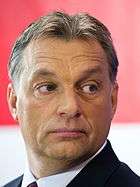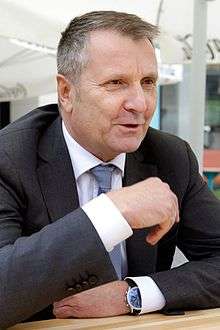Next Hungarian parliamentary election
| | ||||||||||||||||||||||||||||||||||||||||||||||||||||||||||||||||||||||||||||||||||||||||||||||||
| ||||||||||||||||||||||||||||||||||||||||||||||||||||||||||||||||||||||||||||||||||||||||||||||||
| ||||||||||||||||||||||||||||||||||||||||||||||||||||||||||||||||||||||||||||||||||||||||||||||||
| ||||||||||||||||||||||||||||||||||||||||||||||||||||||||||||||||||||||||||||||||||||||||||||||||
The next Hungarian parliamentary elections will be held in or before spring 2018.
Background
At the previous parliamentary election, in April 2014, the incumbent government — composed of the Fidesz and its satellite alliance the Christian Democratic People's Party (KDNP) — was able to achieve a two-thirds majority for the second consecutive time with 44.87 percent of the votes. According to their critics, this overwhelming proportion was only because of the new election law (mostly due the introduction of compensation votes also for the individual winners) which was adopted by the ruling coalition in 2011.[1] In early 2015, however, Fidesz lost its two-third majority following the 2014 Hungarian Internet tax protests and subsequent decrease in support for the government.[2] The governing party suffered defeats at two parliamentary by-elections in February and April 2015, both in Veszprém County.[3][4]
The left-wing electoral alliance Unity, which failed to win the 2014 national election after its five constituent parties gained a total of only 38 seats, broke up shortly thereafter. Its former member parties (MSZP, Együtt–PM and DK) participated in the May 2014 European Parliament election individually, while the MLP did not participate in the election at all. Due to this fragmentation of the left-wing opposition, the radical nationalist Jobbik became the second largest party in a nation-wide election for the first time since its establishment.[5] The PM broke off the permanent nature of its alliance with Együtt on 9 November 2014.[6]
After a few months of crisis for Fidesz from November 2014, which was marked by internal conflicts (e.g. businessman Lajos Simicska's fall from grace within Fidesz) and corruption scandals,[7] the governing party regained much of its lost support during the European migrant crisis during the summer of 2015, when Prime Minister Viktor Orbán announced the construction of a 4-metre-high (13 ft), 175-kilometre-long (109 mi) fence along its southern border with Serbia.[8] The Hungarian government also criticised the official European Union policy for not dissuading migrants from entering Europe.[9] The barrier became successful, as since 17 October 2015 onward, thousands of migrants were daily diverted to Slovenia instead.[10]
On 13 December 2015, the 26th congress of the ruling Fidesz re-elected Viktor Orbán as party leader. Orbán said in his speech that he was ready to lead the party into the forthcoming parliamentary election and continue to serve as prime minister if Fidesz wins re-election in 2018. With that statement, Orbán made it clear that he does not intend to become President of Hungary, succeeding János Áder during the 2017 indirect presidential election.[11]
Electoral system
The 199 members of the National Assembly will be elected by two methods; 106 will be elected in single-member constituencies by first-past-the-post voting, with the remaining 93 elected from a single nationwide constituency by proportional representation. The electoral threshold is set at 5%, although this is raised to 10% for coalitions of two parties and 15% for coalitions of three or more parties, Seats are allocated using the d'Hondt method.[12]
Opinion polls
References
- ↑ "Így csinált a Fidesz kétharmadot az egyszerű többségből" (in Hungarian). 24.hu. 15 April 2014. Retrieved 25 January 2016.
- ↑ "Példátlanul nagyot zuhant a Fidesz és Orbán népszerűsége". Index.hu. 10 December 2014.
- ↑ "Hungary's Ruling Party Loses Two-Thirds Majority after By-Election". The Wall Street Journal. Retrieved 22 February 2015.
- ↑ Dull, Szabolcs. "Győzött a Jobbik a tapolcai választáson". Index.hu. Retrieved 12 April 2015.
- ↑ "Kezdődik az MSZP végjátéka". 26 May 2014. Retrieved 27 May 2014.
- ↑ "Megszűnt az Együtt-PM szövetség". 9 November 2014. Retrieved 9 November 2014.
- ↑ "Thousands protest against corruption, gov't policies". Politics.hu. 17 November 2014.
- ↑ "Hungary to fence off border with Serbia to stop migrants". Reuters. 17 June 2015. Retrieved 28 August 2015.
- ↑ Anemona Hartocollis; Dan Bilefsky & James Kanter (3 September 2015). "Hungary Defends Handling of Migrants Amid Chaos at Train Station". The New York Times. Retrieved 3 September 2015.
- ↑ Barbara Surk & Stephen Castle (17 October 2015). "Hungary Closes Border, Changing Refugees' Path". The New York Times. Retrieved 17 October 2015.
- ↑ "Orbán ráfordult a 2018-as kampányra" (in Hungarian). Index.hu. 13 December 2015. Retrieved 15 December 2015.
- ↑ Electoral system IPU






